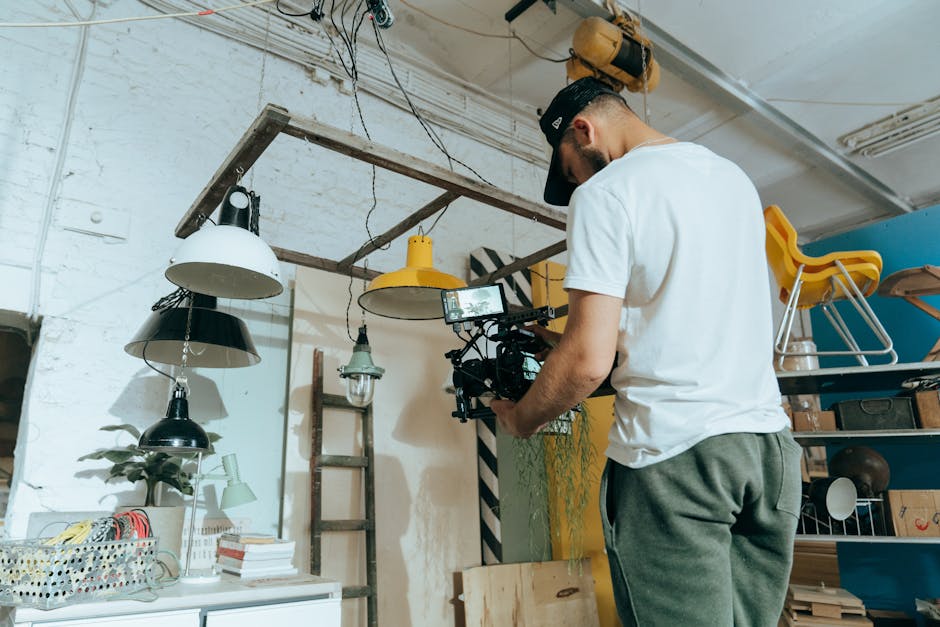From Brooklyn to Broadway: Digital Storytelling in New York
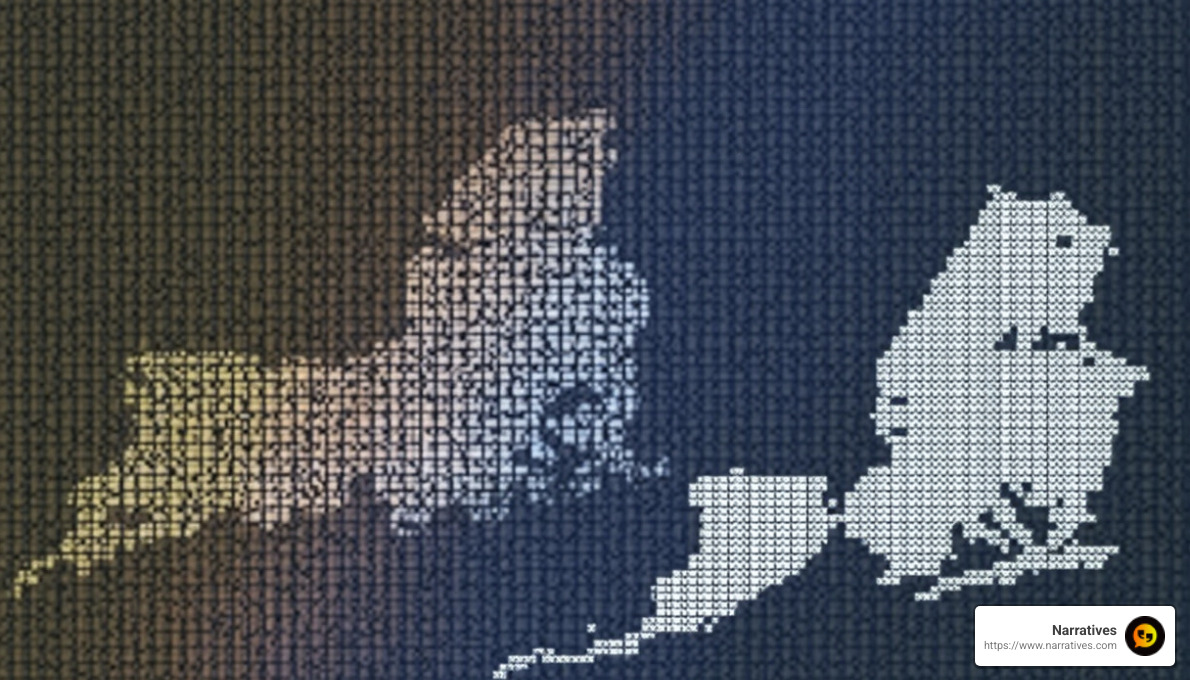
Digital storytelling New York has become a dynamic force, reflecting the city's vibrant and changing media landscape. In the heart of this busy metropolis, the fusion of traditional storytelling methods and cutting-edge digital technology is shaping how stories are told and engaged with.
- What is digital storytelling New York?: A blend of traditional narratives and innovative digital formats.
- Where is it happening?: From Brooklyn's creative hubs to Broadway's iconic stage, New York City is a hotspot.
- Why is it important?: It's revolutionizing how stories about culture, politics, and human experiences are shared.
New York City's diverse backdrop fosters a unique environment for storytellers who are eager to experiment and connect on a deeper level. By leveraging platforms such as podcasts, social media, and immersive experiences, creators are crafting narratives that resonate widely and engage audiences in fresh, compelling ways.
For those interested in using the power of storytelling to amplify their mission or create impactful content, understanding the landscape of digital storytelling New York offers is crucial.
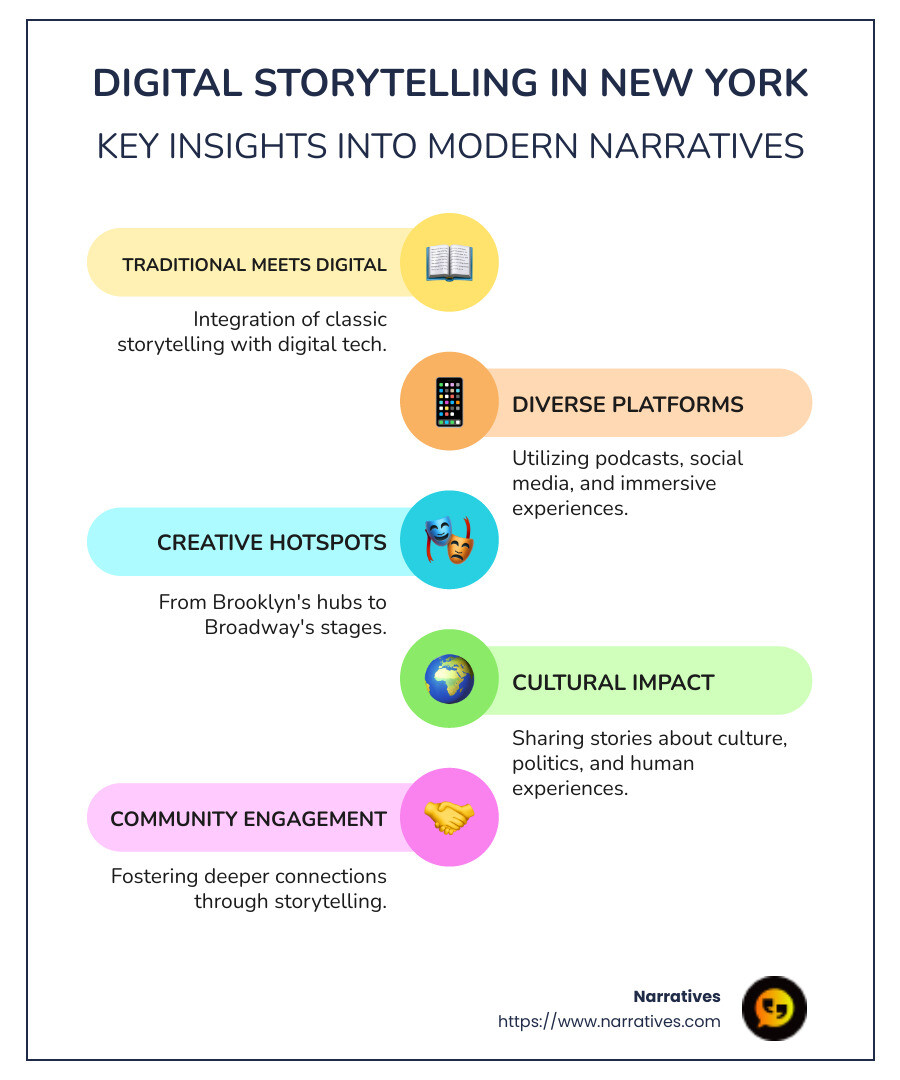
Simple digital storytelling New York word guide:
The Rise of Digital Storytelling in New York
In the vibrant city of New York, digital storytelling has taken on a life of its own. At the intersection of media theory, design, and analysis, storytellers are crafting narratives that captivate audiences across diverse platforms.
Media Theory: This is the backbone of digital storytelling. It helps creators understand how different media forms influence and shape narratives. As Deb Roy from MIT suggests, today's storytellers are experimenting with formats that were unimaginable a decade ago. From short TikTok videos to audio performances on Clubhouse, each platform offers a unique storytelling canvas.
Design: In New York, design isn't just about aesthetics; it's about crafting experiences. Whether it's the sleek interface of a website or the immersive environment of a virtual reality (VR) experience, design plays a crucial role in how a story is delivered and received.
Analysis: Understanding audience engagement is key. With tools like social media analytics, storytellers can gauge the impact of their narratives in real-time. This data-driven approach allows for continuous refinement and adaptation of stories to better connect with audiences.
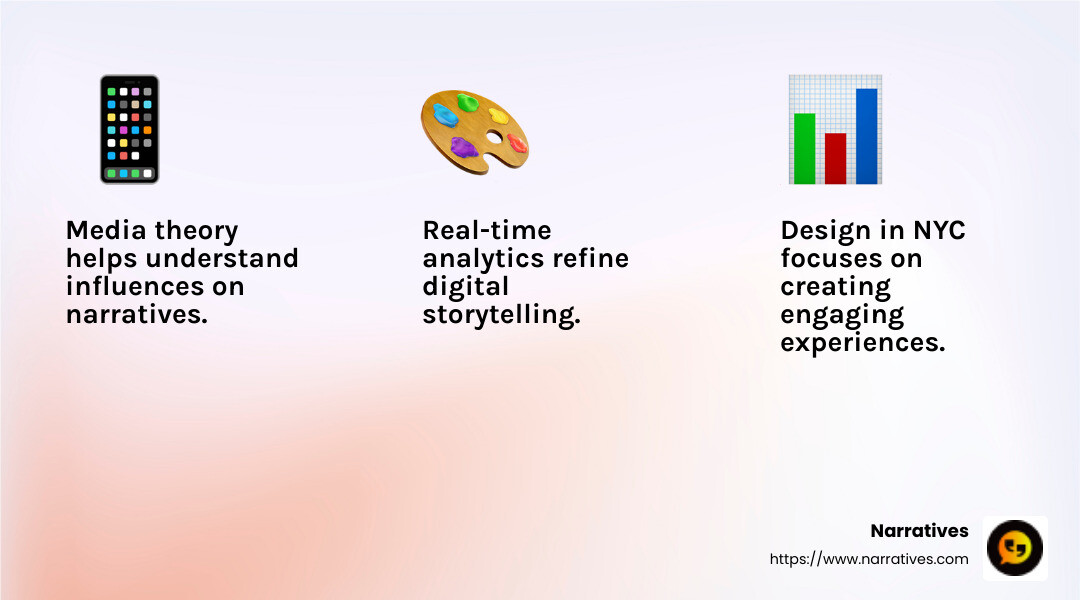
One shining example of innovation in New York is The New York Times' Instagram-first storytelling method. By using high-resolution photos and snackable content, they engage mobile users in a more intimate way. This strategy not only amplifies their news reports but also caters to a millennial audience hungry for visual content.
New York's digital storytelling scene is a melting pot of creativity. From augmented reality (AR) installations to AI-driven narratives, the city is a playground for those looking to push the boundaries of how stories are told.
As we dig deeper into digital storytelling New York, it's clear that the city is not just a backdrop but a catalyst for storytelling innovation. This dynamic environment encourages creators to experiment and evolve, ensuring that the stories of tomorrow are as compelling as they are diverse.
Exploring Digital Storytelling Techniques
Digital storytelling in New York is thriving, thanks to the city's accept of multi-platform content and innovative distribution strategies. Let's explore the techniques that are shaping this dynamic landscape.
Multi-Platform Content
Stories are no longer confined to a single medium. Creators in New York are leveraging multiple platforms to tell their stories, ensuring they reach audiences wherever they are. Whether it's a blog post, a podcast, a YouTube video, or an Instagram story, each platform offers a unique way to engage with content.
For instance, The New York Times has successfully tapped into Instagram's visual storytelling potential. By using high-resolution images and bite-sized content, they create a more intimate interaction with their audience. This approach not only improves engagement but also broadens their reach to younger, mobile-savvy consumers.
Distribution Strategies
Effective distribution is crucial for digital storytelling. In New York, storytellers are using a variety of channels to disseminate their content. Social media platforms like Twitter, Facebook, and TikTok allow for rapid sharing, while newsletters and podcasts offer more in-depth engagement.
The key to successful distribution lies in understanding the audience. Tools like social media analytics help creators tailor their content to match audience preferences, ensuring that stories are not only seen but also resonate with viewers.
Contemporary Techniques
New York's digital storytellers are at the forefront of contemporary techniques, incorporating cutting-edge technology to improve their narratives. Augmented reality (AR) and virtual reality (VR) are being used to create immersive experiences that transport audiences into the heart of the story.
Moreover, the integration of artificial intelligence (AI) in storytelling is opening new possibilities. AI can personalize content, making stories more relevant to individual users. It can also assist in content creation, helping storytellers generate innovative ideas and streamline production processes.
In this changing landscape, New York remains a hub of creativity and experimentation. As digital storytelling techniques continue to advance, the city will undoubtedly play a pivotal role in shaping the future of narrative arts.
With these techniques in mind, let's dive into the educational opportunities available for aspiring digital storytellers in New York.
Top Digital Storytelling Courses in New York
If you're passionate about digital storytelling and want to hone your skills in New York, you're in luck. The city is home to some of the most esteemed courses that can help you master the art of storytelling in the digital age. Let's explore three top programs: Columbia DSL, NYU Magazine, and the Digital Storytelling Lab.
Columbia Digital Storytelling Lab (DSL)
Columbia DSL is a next-gen media lab at Columbia University that combines arts, humanities, and technology to shape the future of storytelling. It offers a range of courses designed to explore new forms and functions of storytelling. Students can dig into subjects like Digital Storytelling I, II, and III, World-building, and Creative Coding. These courses encourage collaboration, creativity, and experimentation, preparing students to tackle real-world challenges through innovative narratives.
The lab is a hub of creativity where students and faculty collaborate on projects that push the boundaries of traditional storytelling. By integrating technology as a creative partner, Columbia DSL is redefining the relationship between creators and audiences.
NYU Magazine and Digital Storytelling Program
At NYU's Arthur L. Carter Journalism Institute, the Magazine and Digital Storytelling Program focuses on developing versatile storytelling skills. This program is perfect for students interested in magazine writing and exploring digital media opportunities. Courses cover feature writing, video journalism, social media, and photography.
Students gain hands-on experience by reporting on events like New York Fashion Week and publishing their work in renowned outlets such as The New York Times and Smithsonian Magazine. This program equips students with the skills needed to produce memorable stories that resonate with diverse audiences.
The Digital Storytelling Lab
The Digital Storytelling Lab is another fantastic resource for aspiring storytellers in New York. It offers non-credit courses that introduce students to various forms of digital storytelling, including podcasts, comics, and interactive media. For example, a five-day intensive course at Fordham University covers everything from podcasting fundamentals to interactive storytelling techniques.
Led by experts like Christopher Vicari, an educational technologist specializing in game-based learning, these courses offer hands-on experience with digital tools and technologies. Students learn to create engaging content and develop a portfolio that showcases their growth in digital storytelling.
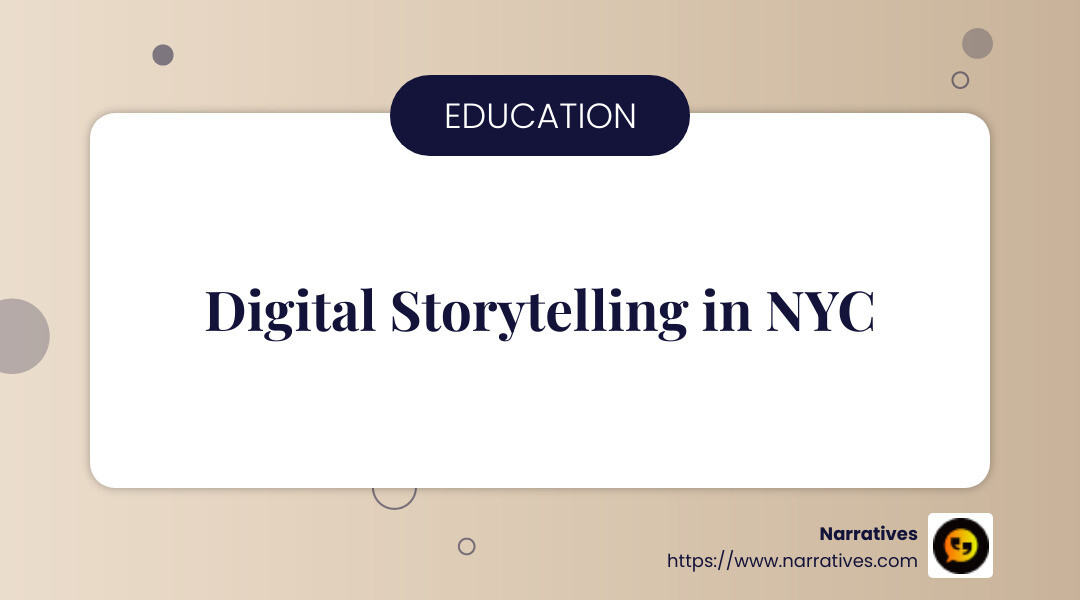
Whether you're interested in traditional journalism or cutting-edge digital media, New York offers a wealth of educational opportunities to help you succeed in the field of digital storytelling. As we continue to explore the city's vibrant storytelling scene, let's take a closer look at key players and innovations shaping this dynamic landscape.
Digital Storytelling New York: Key Players and Innovations
In the busy world of digital storytelling New York, several key players are pushing the boundaries of what storytelling can be. Let's explore the exciting innovations in augmented reality, virtual reality, and AI that are changing narratives in this vibrant city.
Augmented Reality (AR) in Storytelling
The New York Times has been at the forefront of integrating augmented reality into journalism. By adding AR features to its mobile app, the Times allows readers to experience stories in a more immersive way. For instance, during the Winter Olympics, they introduced AR experiences that let users feel as if they were physically close to the events. This innovation helps expand journalism beyond the traditional screen, offering a "provocative explanatory value" to its stories.
Virtual Reality (VR) Experiences
Virtual reality has also made its mark in New York's storytelling landscape. Institutions like the Columbia Digital Storytelling Lab are exploring VR to create immersive storyworlds. Projects like "My Sky Is Falling" use VR to raise awareness about social issues, providing an emotionally impactful experience that traditional media cannot match. Such initiatives not only improve storytelling but also foster empathy and social understanding.
AI in Storytelling
Artificial intelligence is another game-changer in digital storytelling. AI tools are now being used to analyze and improve narratives by understanding emotional arcs and audience responses. According to a McKinsey report, AI can help storytellers objectively evaluate their content, making edits to increase engagement. This could involve tweaking plot elements or incorporating new musical scores to amplify emotional impact. As AI becomes more accessible, it promises to revolutionize how stories are crafted and consumed.
These innovations are just the tip of the iceberg in digital storytelling New York. By embracing new technologies, storytellers are finding novel ways to connect with audiences, making New York a hub for creative and transformative narratives.
Now, let's address some frequently asked questions about digital storytelling in New York and explore its broader impact.
Frequently Asked Questions about Digital Storytelling in New York
What is digital storytelling?
Digital storytelling is the practice of using digital tools and platforms to craft and share stories. It goes beyond traditional media by incorporating multimedia elements such as images, video, audio, and interactive features. This approach allows storytellers to reach a broader audience and engage them in more immersive and dynamic ways.
How is digital storytelling used in New York?
In New York, digital storytelling is thriving across various sectors. Media giants like The New York Times are pioneering new ways of narrative reporting through platforms like Instagram, where they employ visual storytelling to engage mobile users. Their use of augmented reality (AR) in news stories offers readers a deeper experience, making complex topics more accessible.
Educational institutions like the Columbia Digital Storytelling Lab are also at the forefront, exploring innovative techniques such as virtual reality (VR) to create immersive story experiences. These projects often tackle social issues, providing not just entertainment but also fostering empathy and understanding.
New York's vibrant creative scene is also home to numerous startups and non-profits that use digital storytelling to amplify voices and drive social change. Initiatives like those from Narratives focus on humanizing news and creating content that supports community building and empathy.
What are the benefits of digital storytelling for non-profits?
Non-profits in New York leverage digital storytelling to amplify their message and connect with audiences on a personal level. Here are some key benefits:
Improved Engagement: By using multimedia elements, non-profits can create compelling narratives that capture attention and encourage interaction.
Broader Reach: Digital platforms allow stories to be shared widely, reaching audiences who might not be accessible through traditional means.
Empathy Building: Storytelling that focuses on personal experiences and community issues can foster empathy, encouraging audiences to support causes.
Cost-Effective: Digital storytelling is often more affordable than traditional media, making it accessible for non-profits with limited budgets.
Data-Driven Insights: Tools like AI can help non-profits analyze audience engagement, enabling them to tailor their stories for maximum impact.
These advantages make digital storytelling a powerful tool for non-profits aiming to effect social change and build stronger community connections.
Conclusion
In the busy landscape of digital storytelling New York, Narratives is carving out a unique space by championing social impact and community-driven storytelling. Our mission is to lift underrepresented voices through emotionally resonant multimedia content that not only tells a story but also inspires action.
Social impact storytelling is about more than just sharing stories; it's about creating change. By partnering with non-profits and purpose-driven organizations, we help highlight the challenges and triumphs within communities. This kind of storytelling builds trust and visibility, crucial elements for any organization looking to make a difference.
Community-driven storytelling focuses on the people at the heart of these stories. It's about giving a platform to those who are often unheard, allowing their narratives to foster empathy and understanding. This approach not only strengthens community bonds but also empowers individuals by validating their experiences and contributions.
New York is a hub for innovation in digital storytelling, with a rich ecosystem of creatives and technologists pushing boundaries. From the use of augmented and virtual reality to the integration of AI, the city is at the forefront of storytelling evolution. Narratives is committed to using these technologies to amplify impactful stories in ways that resonate deeply with audiences.
As we continue to explore the vast possibilities of digital storytelling New York, we invite you to join us in this journey of change and empowerment. Whether you're a non-profit looking to share your mission or an individual with a story to tell, we are here to support and amplify your voice.
Learn more about how Narratives can help you tell your story.


